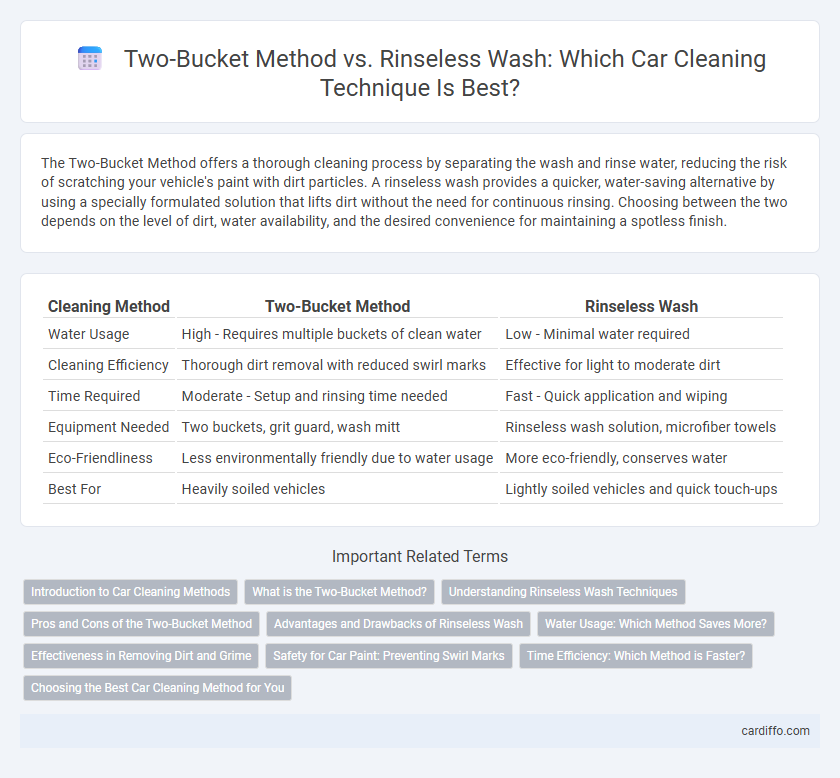The Two-Bucket Method offers a thorough cleaning process by separating the wash and rinse water, reducing the risk of scratching your vehicle's paint with dirt particles. A rinseless wash provides a quicker, water-saving alternative by using a specially formulated solution that lifts dirt without the need for continuous rinsing. Choosing between the two depends on the level of dirt, water availability, and the desired convenience for maintaining a spotless finish.
Table of Comparison
| Cleaning Method | Two-Bucket Method | Rinseless Wash |
|---|---|---|
| Water Usage | High - Requires multiple buckets of clean water | Low - Minimal water required |
| Cleaning Efficiency | Thorough dirt removal with reduced swirl marks | Effective for light to moderate dirt |
| Time Required | Moderate - Setup and rinsing time needed | Fast - Quick application and wiping |
| Equipment Needed | Two buckets, grit guard, wash mitt | Rinseless wash solution, microfiber towels |
| Eco-Friendliness | Less environmentally friendly due to water usage | More eco-friendly, conserves water |
| Best For | Heavily soiled vehicles | Lightly soiled vehicles and quick touch-ups |
Introduction to Car Cleaning Methods
The Two-Bucket Method enhances car cleaning by using separate buckets for soapy water and rinse water, minimizing dirt transfer and potential paint scratches. Rinseless Wash relies on special cleaning solutions that remove grime without the need for water rinsing, ideal for quick or water-restricted washes. Both methods optimize vehicle cleanliness but differ in water usage, application technique, and environmental impact.
What is the Two-Bucket Method?
The Two-Bucket Method is a car cleaning technique that uses one bucket filled with soapy water and another with clean rinse water to minimize dirt transfer and prevent swirl marks on the paint. It involves immersing the wash mitt in the soapy water, scrubbing the surface, then rinsing the mitt in the clean water bucket before reloading soap. This method effectively reduces contaminants and helps maintain a high-gloss finish compared to single-bucket washing.
Understanding Rinseless Wash Techniques
Rinseless wash techniques involve using a specialized cleaning solution that requires little to no water, making it ideal for areas with water restrictions or quick touch-ups. Unlike the two-bucket method, rinseless wash minimizes water usage by allowing dirt to be encapsulated and wiped away without rinsing, reducing the risk of swirl marks and contaminants. Proper application involves using microfiber towels and a dilution ratio specific to the product to ensure effective cleaning without leaving residue.
Pros and Cons of the Two-Bucket Method
The Two-Bucket Method minimizes the risk of scratching vehicle paint by separating the wash bucket from the rinse bucket, effectively reducing dirt transfer during cleaning. Its primary advantage is enhanced paint protection and thorough dirt removal, but it requires more water and time compared to rinseless wash techniques. The method demands physical effort and access to a water source, which can be less convenient for quick or water-restricted situations.
Advantages and Drawbacks of Rinseless Wash
Rinseless wash offers significant water conservation compared to the two-bucket method, using minimal water and reducing runoff, which benefits environmentally sensitive areas. It requires less setup and is quicker for light dirt removal, making it ideal for gently soiled vehicles or quick touch-ups. However, rinseless wash may struggle with heavy grime, increasing the risk of surface scratches if grit is not effectively removed, whereas the two-bucket method provides better dirt separation and reduces contamination during cleaning.
Water Usage: Which Method Saves More?
The two-bucket method typically uses between 2 to 4 gallons of water by separating the wash and rinse buckets, minimizing dirt transfer and reducing overall water consumption. Rinseless wash methods use significantly less water, usually around 1 to 2 gallons, by relying on specialized cleaning solutions and microfiber towels to lift dirt without rinsing. Comparing water usage, rinseless wash saves more water, making it ideal for areas with water restrictions and eco-conscious car care.
Effectiveness in Removing Dirt and Grime
The Two-Bucket Method excels in effectively removing dirt and grime by minimizing cross-contamination between the wash and rinse buckets, ensuring a thorough cleaning process. Rinseless Wash offers convenience and water conservation while providing adequate dirt removal for lightly soiled surfaces, but it may struggle with heavy grime buildup compared to the Two-Bucket Method. For optimal cleanliness on heavily soiled vehicles, the Two-Bucket Method remains the most effective technique.
Safety for Car Paint: Preventing Swirl Marks
The Two-Bucket Method minimizes the risk of swirl marks by separating dirty water from clean water, reducing the chance of abrasive particles scratching the car paint. Rinseless Wash relies on specially formulated detergents that encapsulate dirt particles, allowing safe cleaning without water, but improper use can still leave residues that may cause micro-scratches. For optimal paint protection, the Two-Bucket Method provides superior dirt control, while rinseless wash requires careful technique and regular microfiber cloth replacement to prevent swirl marks.
Time Efficiency: Which Method is Faster?
The rinseless wash method typically offers greater time efficiency compared to the two-bucket method by eliminating the need for frequent water changes and reducing overall rinsing time. While the two-bucket method provides thorough dirt removal and minimizes contamination, it requires more time to dip, wash, and rinse repeatedly. For fast, effective cleaning with minimal water use, rinseless wash is often preferred by detailers who prioritize speed.
Choosing the Best Car Cleaning Method for You
The two-bucket method effectively reduces dirt transfer and scratches by using separate buckets for washing and rinsing, making it ideal for heavily soiled vehicles. Rinseless wash offers convenience and water savings, perfect for light cleaning and areas with water restrictions. Assess your car's condition, environmental factors, and available time to determine the best cleaning approach that balances efficiency and protection.
Two-Bucket Method vs Rinseless Wash Infographic

 cardiffo.com
cardiffo.com